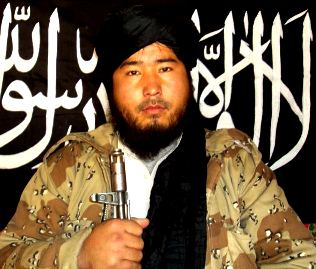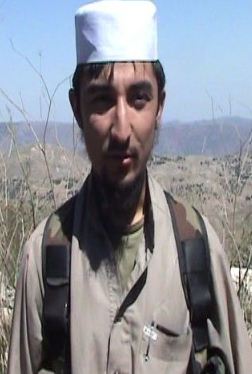 |
|
Abbos Mansoor, the military commander for the Islamic Movement of Uzbekistan who was killed in 2011. Image from Furqoon, the IMU’s website. |
The al Qaeda-linked Islamic Movement of Uzbekistan recently issued a video that eulogized a media operative and their top military commander, who was killed “by an unmanned plane of the enemy.”
The IMU video, titled “What’s Happening in Tribal Areas? Part-9,” praises the deaths of “Commander Abbos Mansoor” and “Brother Abdul Aziz.” The videotape was released yesterday by Jundullah Studio, the IMU’s media arm, on al Qaeda-linked jihadist web forums, and has been translated by the SITE Intelligence Group.
The IMU first announced the deaths of Mansoor, Aziz, and 85 other operatives in a statement released on their website, Furqoon, on Nov. 30, 2011. The statement provided short biographies of those killed. [See LWJ report, IMU names 87 ‘martyrs’ killed during past year.] Mansoor was the first IMU commander listed in the Nov. 2011 announcement, indicating his importance.
The video begins with a eulogy of Mansoor and Aziz by Abu Usman Adil, the emir or leader of the Islamic Movement of Uzbekistan. Adil praised the two men, who “always obeyed my orders as well, without any slowness,” according to the SITE translation.
The video focuses primarily on Mansoor, who “was martyred by an unmanned plane of the enemy.” It is unclear if Mansoor was killed in Afghanistan or Pakistan; the martyrdom statement indicated that he fought on both sides of the porous Afghan-Pakistani border, and the unmanned US drones also operate in both countries. But the title of the videotape, “What’s Happening in Tribal Areas?”, indicates he may have been killed in Pakistan’s tribal areas.
Mansoor was from Kyrgyzstan, and “made hijrah [emigration] to Tajikistan and became a member of Islamic Movement at the age of 19,” in 1998, according to the videotape. “After finishing his military education, he became a bodyguard to commander Jumabai,” the statement continued, in reference to Juma Namangami, one of the co-founders of the IMU. Namangami was killed was killed by anti-Taliban fighters from the Northern Alliance during the US invasion of Afghanistan in November 2001.
He traveled to Afghanistan sometime afterward and became “a bodyguard for Muhammad Tahir ‘Farooq,'” or Tahir Yuldashev, the prior emir of the IMU who was killed in a US drone strike in Pakistan’s tribal agency of South Waziristan in August 2009. Yuldashev co-founded the Islamic Movement of Uzbekistan with Namangani.
The IMU said that Mansoor “participated in the famous Shah-i-Kot battle and later participated actively in the jihad of Pakistan,” likely a reference to fighting against the Pakistani military in the tribal areas from 2004 to the present day. Mansoor’s presence at the Battle of Shah-i-Kot (Operation Anaconda) in Afghanistan’s eastern province of Paktia in March 2002 is logical, as Yuldashev is known to have fought alongside al Qaeda against US forces there.
Adil, the IMU emir, named Mansoor the “Chief Military Commander of Islamic Movement of Uzbekistan” just days before he was killed in the drone strike.
The video also features several posthumous videoclips of Mansoor. In one clip, Mansoor said that “Pakistan cannot make us distressed with these battles. We should be
proud of our shuhada [martyrs].” In another, Mansoor claimed that “only 30-40 brothers with limited ability” fought for several days “against 300-400 troops of NATO Crusaders and Afghan National Army.”

|
|
Abdul Aziz. Image from Furqoon. |
Adbul Aziz was described as “a sharp young man from Tashkent,” Uzbekistan, who was “blessed to have participated in jihad of Afghanistan and Pakistan against NATO and its slaves and munafiqeen [hypocrites] for six years.” He “actively participated in the promotion department of Jundullah Studios,” where he essentially served as a combat cameraman, editor, and producer. The IMU and another terror groups in the region often record their operations against NATO, Afghan, and Pakistani forces.
Aziz’s role in the filming and production of the What’s Happening in Tribal Areas “video series” had “earned a place in the hearts of Arab,” or al Qaeda, “and Ajam [non-Arab]” fighters, the statement concluded. Given his job, he may have been killed while filming IMU military operations in Afghanistan or Pakistan.
Background on the IMU
The Islamic Movement of Uzbekistan is an al Qaeda-affiliated group whose leadership cadre is based primarily in Pakistan’s Taliban-controlled tribal agency of North Waziristan. The terror group operates primarily along the Afghan-Pakistani border and in northern Afghanistan. According to one estimate, more than 3,000 Uzbek, Central Asian, and other foreign fighters belonging to the IMU are sheltering in North Waziristan.
The IMU continues to maintain a close working relationship with al Qaeda, the Taliban, and the Haqqani Network. The Pakistan-based terror group has integrated into the Taliban’s shadow government in the Afghan north, and conducts operations with the Haqqani Network in the east. In addition, the IMU has been involved in several high-profile suicide attacks and assassinations in Kabul and in the north.
For more information on the IMU, see LWJ reports, IMU cleric urges Pakistanis to continue sheltering jihadis in Waziristan, and ISAF captures IMU facilitator in Wardak province.








6 Comments
Be the next to step on up and our people will deal you the same fate.
Nice to see that our drone strikes are sometimes killing relatively important players, but I fear way more often than not, we’re killing Abdul Azizs rather than Abbas Mansours.
Here’s a little visualization I put together last fall on the IMU, where LWJ was a great reference.
http://www.isvg.org/follow/blog/2011/10/24/the-islamic-movement-of-uzbekistan-imu-one-of-central-asias-most-dominant-terrorist-groups/
He’s either well fed or gets that’s puffiness that’s common among users of narcotics who live a pampered life style. Being in my late 50’s just about every, guerrilla, insurgent, revolutionary, anarchist etc., that I’ve become familiar with over the last 40 years usually sported a gaunt sallow look. Many of these ‘people’ are obviously not full time field operatives.
It’s obvious many of the images of the AfPak ‘insurgents’ are those of people in well laundered attire and also have that aura about them common among habitual opium and heroin users. Another feature that’s little quoted on if at all is that many of the ‘insurgents,’ particularly the rank & file, have that feral look common among methamphetamine users.
re:rk
very cool thank you for doing that
@ mike merlo,
The GWOT can be won through research, intel, and analyzing of every detail of the enemy, and then, by hitting them hard at their weak point, but not by profiling them. Well fed, maybe; however, I am a little hesitant about imagining Yuldashev assigning a “pothead” as his head of security/personal bodyguard.
The article says Mansoor was from Kyrgyzstan, so that mongoloid face might explain that puffiness. As a bodyguard, he possibly was a heavy weight wrestler/sambo martial arts fighter, and/or Buzkashi player (All three sports rely on heavy training and big body mass and are popular in Central Asia).
Possibly this was why a UAV/extreme force dealt with situation.
re: SUN
“…but not by profiling them.” That’s about as absurd comment as I’ve ever heard that has the propensity of surfacing with nauseating regularity. That’s the equivalent of looking for cats while knowing dogs are the culprits of soiling ones lawn.
I don’t care want your body type is. Spend X amount months or extended periods of time in the ‘theater’ ‘humping’ the terrain & one’s physique will reflect that. Inspecting physique’s, doing digestive forensic’s & blood test’s on adversaries immediately upon kill or capture is one of the best sources of evidence.
Though little commented on, if at all, use of narcotics & substance abuse is quite common among the insurgents.